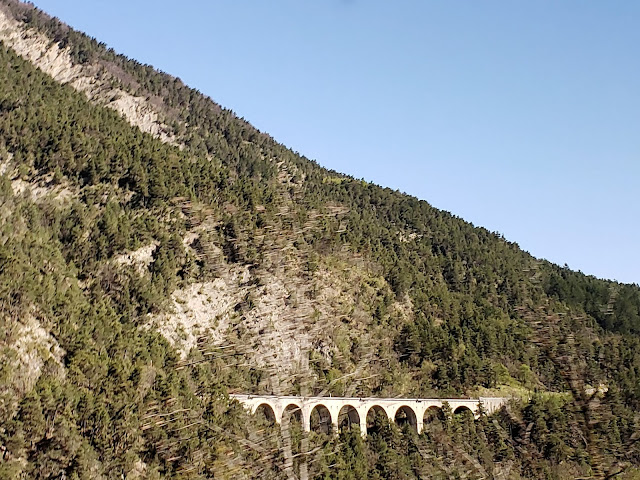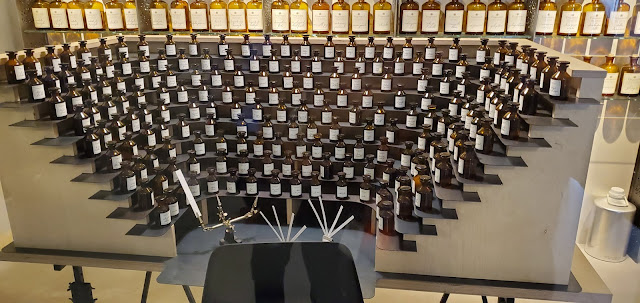DAY 6, Monday - Fields of Provence, French Riviera
LUGGAGE OUT - 7 AM
DEPART - 8 AM
Heading south, pass the Olympic city of Grenoble at the foot of the French Alps on your way through the colorful landscapes of Provence, an inspiration for the early Impressionist painters. Here, Matisse, Van Gogh and Picasso created their masterpieces inspired by the region's incredible beauty and soft light.
We made a short photo stop.
Travel past the olive groves and pine forests to the picturesque fortified town of Sisteron, nestled between the mountains and the sea, with its hilltop villages and impressive remains of 14th-century walls.
Sisteron is situated on the banks of the River Durance just after the confluence of the rivers Buëch and Sasse. It is sometimes called the "Gateway to Provence" because it is in a narrow gap between two long mountain ridges.
Sisteron has been inhabited for 4000 years. It was first fortified by the Counts of Forcalquier in the 11th century and later was the northern boundary of the domain of the Counts of Provence. In 1483 during the reign of Louis XI, Sisteron re-joined the kingdom of France. Around this time there were seven plagues that killed two thirds of the population. Between 1562 and 1594 the town and its citadelle was fought over by Protestants and Catholics including two sieges.
During the French Revolution the town remained Royalist. Consequently, when Napoleon arrived on his march north after his escape from Elba in 1815, the town ignored him and let him through.
On 15 August 1944 French B-26 Marauder bombers and American B-17 Flying Fortresses of the 42nd Bomber Wing tried to destroy the railway bridge and the road bridge which spans the Durance. The weather was unfavorable and the bridges were not destroyed. A bomber during a manoeuvre to avoid a collision accidentally dropped several bombs on the town, including a full church, causing about 100 fatalities and seriously damaging the citadel. On 17 August the French aircraft returned and destroyed the bridges.
Sisteron was a quick lunch stop, unfortunately it was Monday so very little was open.
Some opted to walk down to the rocher de la Baume rock.
We opted for a "white" ham sandwich. So delicious and so inexpensive.
The citadel, a mix of diverse architecture dating from the 12th to the 19th century, is certainly the main attraction.
From the 12th century, only the powerful keep and parapet walk still exist. The ramparts were built in the 16th century, due to the Wars of Religion, and some of the gates are closed by drawbridges. Other alterations were made in the 19th century. Between 1939 and 1945, temporary buildings were constructed when the citadel was used as a prison by the Germans and the Vichy government. Bombing by the allied forces cause considerable damage to the citadel, as well as killing more than a hundred people of Sisteron.
Today, the citadel has been remarkably restored and offers guided tours, an open tour with sound system in six different languages, a film and exhibitions, among other activities.
Sisteron Cathedral, now the Church of Notre-Dame-des Pommiers (Cathédrale or Concathédrale Notre-Dame-et-Saint-Thyrse de Sisteron; Église Notre-Dame des Pommiers, or "Our Lady of the Appletrees") is a Roman Catholic church.
Next, a visit to a French perfumery. Hear about the many ways to produce this major export and try some of the popular fragrances. The aromas are amazing!
Another been there, done that moment. It's really just a shameless shopping stop.
We saw a perfumerie in Cologne Germany in 2012. However, this was an interesting stop.
Fragonard is a French perfumery, from the Southern region of France in Grasse.

Interesting discussion by the guide as she asked where we came from. Canada contributed pine, Australia eucalyptus.
Back on the bus and Laura had a lavender sample for each of us.
A WW II memorial of Victory and thanks to Great Britain.
Nestled between glitzy Nice and Cannes, the resort town of Antibes is known for two things: multi-million-dollar mega yachts and a maze-like Old Town encased by 16th-century ramparts. The Côte d'Azur's second-largest town is home to 80,000 inhabitants and the largest marina in the Mediterranean Sea, Port Vauban, which has been attracting ships of a different variety since before the times of the Roman Empire.
Overnight: French Riviera
AC Ambassadeur Antibes, Juan Les Pins
The hotel is situated in the town of Juan Les Pins. The Gare de Juan Les Pins railway station is about a half mile away.
The hotel is now a Marriott, nicely located in Juan Les Pins.
Tonight, at dinner with wine, a taste of the French Riviera's specialties.
Dinner was frozen salmon and not very impressive, definitely not a taste of the French Riviera's specialities.
After dinner Laura took us on a quick orientation of town as not everyone was taking the two optional tours tomorrow.
Laura specifically suggested we stop and have a drink at the Belles Rives Hotel.
After the first World War, American railway tycoon Frank Jay Gould opened a swanky seaside resort in neighboring Juan-les-Pins that was home to the region's first luxury hotel and casino, drawing the likes of Scott Fitzgerald, Charlie Chaplin, Marlene Dietrich and Picasso.
F. Scott Fitzgerald’s quotation engraved in marble evokes the happiest moments in his life at the villa « Saint Louis ». Placed officially on one of the walls in the entrance hall in the presence of his granddaughters, Eleanor Ann & Cecilia Scott, it feels as though the message is personally addressed to the guests.
The history of the Belles Rives begins with a discovery: the ‘Lost Generation’, composed of a disenchanted youth and artists broken by the First World War, heads to the South of France and invents the Côte d’Azur.
Heading up the American trend for between-the-wars literature, F. Scott Fitzgerald and his wife, Zelda, pack their bags in 1925 for the French Riviera and succumb to the charm of a dwelling called the « Villa Saint-Louis » in a cove on the Cap d’ Antibes.
It’s here that he writes his masterpiece, ‘Tender is The Night’, transforming Villa Saint Louis into a resort for wealthy Americans discovering the pleasures of wild partying and swimming in the sea.
His time spent on the Riviera provides him with the inspiration several years later for ‘The Great Gatsby’, in which one imagines the extravagant couple throwing many parties on a terrace by the sea with celebrities such as Rudolph Valentino, Hemingway, Franck Jay Gould, Maurice Chevalier and Pablo Picasso, and where a green light always shines on the horizon…








































No comments:
Post a Comment
This blog does not allow anonymous comments.